|
Horse omnibus services in the Black
Country
The first horse omnibus service in
England began operating in Manchester in 1824. The
pioneering services were so successful that others soon
followed, mainly in the north of England, and London.
The omnibuses operated in a different
manner to stage and mail coaches. In order to travel on a
coach, even for a short distance, the journey had to be
pre-booked at a booking office. After booking, the traveller
had to wait for a hand-written receipt. On the omnibuses,
fares were taken on the vehicle, and no tickets were issued.
The bus owner relied on the honesty of his staff to
hand-over the takings.
The earliest record of a horse-drawn
omnibus running to Wolverhampton was in 1833 when Mr. George
Bayley of Darlaston, operated a nine-seater vehicle to
Wolverhampton from the Waggon and Horses in King Street,
Darlaston, every Wednesday. He also operated a service to
Birmingham, along with Obadiah Howl's omnibuses which
started from the Bell Inn in Church Street, Darlaston. The
services to Birmingham ran on Mondays, Tuesdays, Thursdays,
and Saturdays.
In 1835 an omnibus service began
operating from the Fountain Inn in New Street, Birmingham to
the Pack Horse Inn in Dudley Street, Wolverhampton, run by
Mr. John Doughty. In September of the following year, the
Midlands Omnibus Company opened an office in Dudley Street,
Wolverhampton from where services ran to High Street in
Birmingham. By 1838 the company ran four direct journeys
daily, and two via Walsall, from the Crown & Cushion, in
Dudley Street, Wolverhampton. By 1847 the number of journeys
from the Crown & Cushion to Birmingham had increased to
seven daily, the journey taking 95 minutes. The coach went
via Bilston, and West Bromwich. Another coach ran twice
daily from the pub to Walsall via Willenhall, and yet
another coach ran on the same route from the Red Cow, in
Dudley Street, three times daily. |
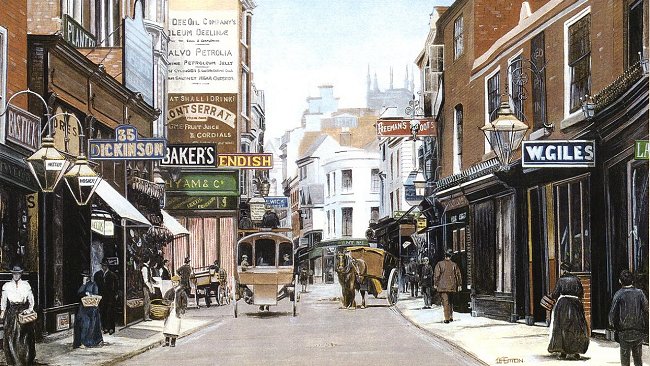
Dudley Street in Wolverhampton. In
the centre, the rear of a horse-drawn omnibus can be
seen, on its way from one of the nearby coaching inns.
From a painting by Alan Eaton. |
|
Another service to Birmingham also
started in 1836, run by the Birmingham Omnibus Conveyance
Company. Two journeys were made daily from the Castle Inn,
Dudley Street, Wolverhampton. By 1838 omnibuses were also
running to Ironbridge, Shifnal, Wednesbury, and Willenhall.
Rushton’s omnibus departed from the
Three Tuns in Queen Street, every Monday and Wednesday at
3.30 p.m., and travelled to Shifnal, Madeley, and Ironbridge.
Every Wednesday at 6 p.m., Cross’s omnibus left the
New Angel in Dudley Street for Wednesbury. Also on
Wednesdays at 5 p.m., a bus left the Bird-in-Hand in High
Green for Stourbridge.
The early omnibuses benefitted from the
coming of the railways. When Wednesfield Heath Station
opened in 1837 there were omnibus services running between
the station and Wolverhampton, meeting every train. By the
late 1840s, omnibuses travelled to the station from the Old
King’s Head Inn in Dudley Street, the Star & Garter in Cock
Street, and the Swan in High Green. Buses from the Star &
Garter, and the Swan also called at all of the principal
inns in the town. Services continued until the opening of
Queen Street Station (Wolverhampton High Level) where people
could arrive or depart from a train in the centre of town.
When Wolverhampton Low Level Station opened in July 1854
only a single omnibus service to the railway stations still
operated. It ran from the Star & Garter and the Swan. The
railway companies soon started running their own cabs, the
taxis of the day, and so the omnibus service to the stations
soon declined. By this time the roads were becoming
neglected because of the disappearance of the stage and mail
coaches, which led to a reduction in the number of omnibuses
in operation.
|
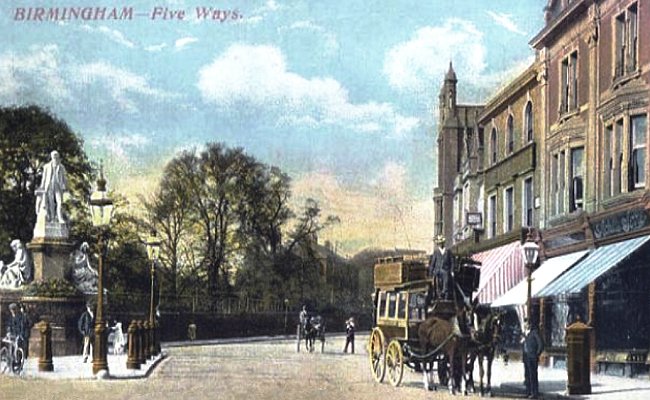
An omnibus at Birmingham. From an old
postcard.
|
By 1871 the omnibuses to Birmingham and
Walsall had ceased to run, possibly because of the frequent
rail services. At this time, two new bus services were
listed. One was to Tettenhall Wood via Tettenhall which ran
five times daily from Five Ways, via Queen Street and Queen
Square. The other went from the High Level Station to Bridgnorth once a day, except on Sundays.
When the horse-drawn trams began to
operate in 1878, the Tettenhall omnibus service soon ended.
A similar event took place a few years later. By 1879 Mr. J.
E. Whitmore of Dudley was running an omnibus service from
Dudley to Wolverhampton, until the horse-drawn trams
began running between Wolverhampton and Dudley in 1883. The
omnibus service was then scrapped. |
|
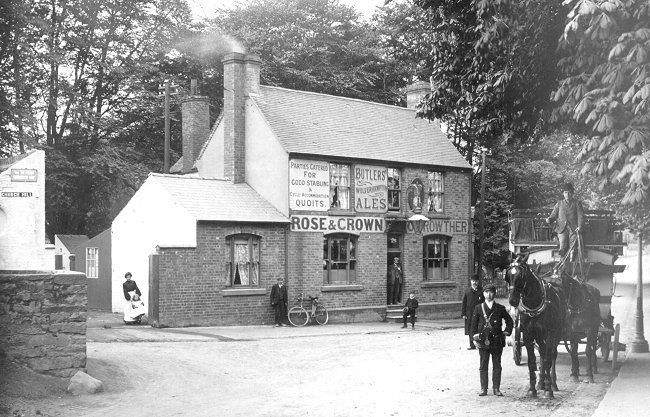
The Rose & Crown at Penn. On the
right is Sampson Tharme's omnibus. Courtesy of St.
Bart's Church. |
|
In 1882 a new omnibus service began to
operate between Queen Square and the Rose & Crown at Penn.
It ran five times daily, and was run by Sampson Tharme of 17
Thornley Street, and W. E. (Billy) Hill of 42 Cobden Street.
They also provided services to Compton, Whitmore Reans and
Gorsebrook. They started a service along Dudley Road which
was almost certainly operated by Billy Hill. In 1902
Wolverhampton Corporation began running omnibus services on
Dudley Road during the reconstruction of the old
horse-tramway, which put Billy Hill out of business.
Tharme’s services couldn’t compete with
those run by the Corporation. By 1904 the service to
Whitmore Reans run by Sampson Tharme and Mr. Armstrong had
succumbed to the new trams, and Tharme’s Penn bus service
had to be cut back to Owen Road Post Office, with a fare of
one penny. In 1905 the omnibuses to Gorsebrook and
Wednesfield ceased to run, although a new service run by a
Mr. Hughes began to operate from the Mitre Hotel in Queen
Street to Wombourne.
On 30th September, 1905, a month after
the Corporation had started the motor bus service to Penn
Fields, Sampson Tharme wrote to the town clerk stating that
he was willing to enter into an agreement not to ply along
Lea Road in consideration of an ‘indemnity’ of £250. He
stated that he had not reduced his fares to compete with the
motor bus and added the following plea:
Thinking that my long services (23
years) to the borough as omnibus provider may entitle me to
the consideration of the council, I would thank you to place
the matter before the proper tribunal.
Unfortunately his letter was ignored.
By 1907 his Owen Road service had ended because it could not
compete with the Corporation’s motor buses, and by 1909 his
service to Bradmore only ran on Wednesdays and Saturdays. By
that time more passengers were carried on the Corporation’s
motor bus services to Lea Road, because of the irregularity
of Tharme’s services. Tharme’s Penn service ended in 1910.
This closed the omnibus career of Sampson Tharme, the last
of the early omnibus operators in the town. He had once been
a well-known figure. His notepaper was simply headed
‘Sufficient address: Sampson Tharme, Wolverhampton.’ |
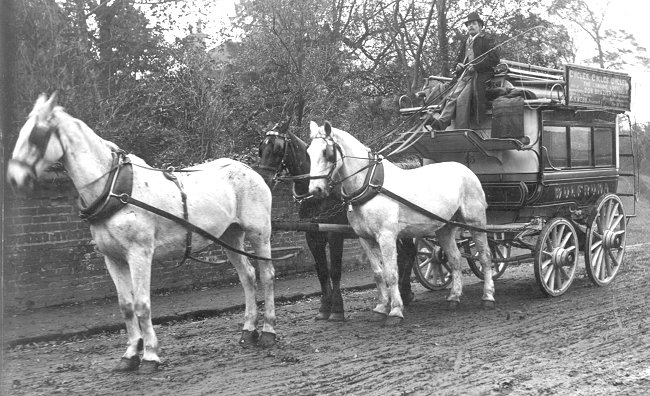
Another view of Sampson Tharme's
horse-drawn omnibus called 'Wulfruna', on Penn Road at
its junction with The Avenue. Courtesy of St. Bart's
Church. |
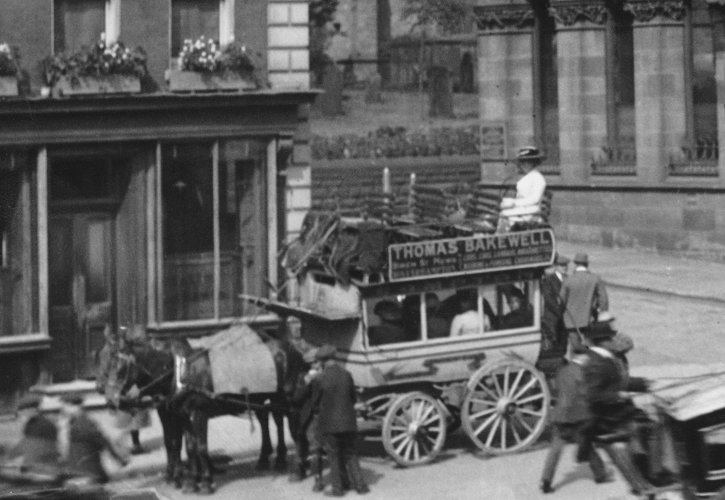
A horse drawn omnibus in Queen Square at
the bottom of Lich Gates.
 |
|
 |
|
 |
Return to
Coaches |
|
Return to the
beginning |
|
Proceed to
Horse Trams |
|